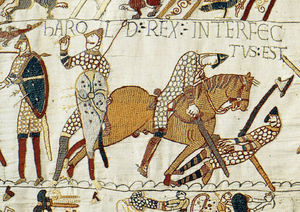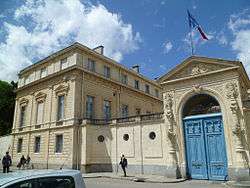Calvados (department)
| Calvados | |||
|---|---|---|---|
| Department | |||
|
Prefecture building of the Calvados department, in Caen | |||
| |||
 Location of Calvados in France | |||
| Coordinates: 49°02′N 0°15′E / 49.033°N 0.250°ECoordinates: 49°02′N 0°15′E / 49.033°N 0.250°E | |||
| Country | France | ||
| Region | Normandy | ||
| Prefecture | Caen | ||
| Subprefectures |
Bayeux Lisieux Vire-Normandie | ||
| Government | |||
| • President of the General Council | Jean-Léonce Dupont (New Centre) | ||
| Area1 | |||
| • Total | 5,548 km2 (2,142 sq mi) | ||
| Population (2013) | |||
| • Total | 689,945 | ||
| • Rank | 34th | ||
| • Density | 120/km2 (320/sq mi) | ||
| Time zone | CET (UTC+1) | ||
| • Summer (DST) | CEST (UTC+2) | ||
| Department number | 14 | ||
| Arrondissements | 4 | ||
| Cantons | 25 | ||
| Communes | 621 | ||
| ^1 French Land Register data, which exclude estuaries, and lakes, ponds, and glaciers larger than 1 km2 | |||
Calvados (French pronunciation: [kal.va.dos]; English /ˈkælvədoʊs/) is a department in the Normandy region in northwestern France.[1] It takes its name from a cluster of rocks off the English Channel coast.
History
Calvados is one of the original 83 departments created during the French Revolution on 4 March 1790. It was created from a part of the former province of Normandy. The name "Orne inférieure" was originally proposed for the department, but it was ultimately decided to call the area Calvados after a group of rocks off its coast.
One popular legend ascribes its etymology to the Salvador, a ship from the Spanish Armada that sank by the rocks near Arromanches-les-bains in 1588. It is more likely, however, that the name Calvados was derived from calva dorsa, meaning bare backs, in reference to two sparsely vegetated rocks off its shore.[2]
After the allied victory at Waterloo the department was occupied by Prussian troops between June 1815 and November 1818.
On 6 June 1944, the Allied forces landed on the beaches of the Bay of the Seine in what became known as the Battle of Normandy.
Geography
Calvados belongs to the region of Normandy and is surrounded by the departments of Seine-Maritime, Eure, Orne and Manche. To the north is the Baie de la Seine, part of the English Channel. On the east, the Seine River forms the boundary with Seine-Maritime. Calvados includes the Bessin area, the Pays d'Auge and the area known as the "Suisse normande" ("Norman Switzerland").
The most notable places in Calvados include Deauville and the formerly elegant 19th-century casino resorts of the coast.
Economy
Agriculture dominates the economy of Calvados. The area is known for producing butter, cheese, cider and Calvados, the apple-based spirit that takes its name from the area.
Politics
The President of the General Council is the centrist Jean-Léonce Dupont, the former dominant figure of the right and centre in the department. The Conseil General of Calvados and Devon County Council signed a Twinning Charter in 1971 to develop links with the English county of Devon.[3]
| Party | seats | |
|---|---|---|
| Socialist Party | 18 | |
| • | Miscellaneous Right | 18 |
| • | Union for a Popular Movement | 6 |
| Left Radical Party | 3 | |
| • | New Centre | 3 |
| • | MoDem | 1 |
Demography
The inhabitants of Calvados are called "Calvadosiens" (male) and "Calvadosiennes" (female). In 1999, Calvados had 648,299 inhabitants, making it the 30th most populated French department.
Age distribution in Calvados:
- 75 years and older: 7.2%
- 60 – 74 years old: 13.16%
- 40 – 59 years old: 25.52%
- 20 – 39 years old: 28.53%
- 0 – 19 years old: 25.6%
Culture
The Bayeux Tapestry is on display in Bayeux and makes the city one of the most-visited tourist destinations in Normandy. Juno Beach Centre at Courseulles-sur-Mer, Calvados, commemorates the D-Day landing of the Canadian liberation forces at Juno Beach during World War II in 1944. The cult of Saint Thérèse de Lisieux brings large numbers of people on pilgrimage to Lisieux, where she lived in a Carmelite convent. Every September, Deauville hosts the Festival of the American Movie and the beach resort of Cabourg hosts the Festival of the Romantic Movie. Annually, the city of Caen celebrates the festival of the electronical cultures called "Nordik Impakt" & The festival of Beauregard, just around Caen.
The local dialect of the Norman language is known as Augeron. It is spoken by a minority of the population.
Tourism
Calvados is one of the most visited areas in France because of its seaside resorts which are among the most prestigious in France with their luxurious hotels, casinos, green countryside, manors, castles, the quiet, the chalk cliffs, the typical Norman houses, the history of William the Conqueror, Caen, Bayeux, Lisieux, the famous D-day beaches and numerous museums about the Second World War. The culinary specialties from the verdant countryside of Calvados are abundant: cider, calvados, camembert and Pont-l'Évêque cheeses.
One of the advantage of Calvados is to be fairly near large urban centers (Paris, Ile de France). Calvados is therefore often preferred for holidays and for weekends and sometimes considered as the countryside of Paris .
Calvados, via the port of Ouistreham, is an entrance to the continent from Britain. There are two airports: Caen-Carpiquet and Deauville-Saint Gatien. The department of Calvados has several popular tourist areas: the Bessin, the Plain of Caen, the Bocage Virois, the Côte de Nacre, the Côte Fleurie and the Pays d'Auge. Several beaches of Calvados are popular for water sports, including Cabourg and Merville-Franceville-Plage.
Tourist capacity (2001):
- 7,818 hotel rooms
- 13,734 camping sites
- 1,176 beds (holiday villages)
- 619 rural gites
Municipalities with more than 10% of second homes
This ranking takes into account all the municipalities having over 10% of second homes in the departement of Calvados. 80% of owners are from the Paris area, 10% are English and 10% are local.
According to the general census of the population of 1 January 2006, 18.9% of housing available in the department were second homes.
Table
| City | Municipal Population | Number of homes | Second home | % Second home |
|---|---|---|---|---|
| Villers-sur-Mer | 2,541 | 9,280 | 7,857 | 84.67% |
| Cabourg | 3,965 | 10,106 | 8,039 | 79.54% |
| Houlgate | 1,902 | 4,658 | 3,665 | 78.67% |
| Tourgéville | 922 | 2,423 | 1,888 | 77.92% |
| Benerville-sur-Mer | 491 | 1,233 | 924 | 74.93% |
| Varaville | 767 | 1,477 | 1,106 | 74.88% |
| Gonneville-sur-Mer | 581 | 899 | 651 | 72.41% |
| Colleville-sur-Mer | 167 | 270 | 195 | 72.22% |
| Blonville-sur-Mer | 1,546 | 2,714 | 1,951 | 71.90% |
| Deauville | 3,973 | 7,794 | 5,484 | 70.36% |
| Merville-Franceville-Plage | 1,740 | 2,535 | 1,694 | 66.81% |
| Saint-Côme-de-Fresné | 219 | 294 | 196 | 66.64% |
| Danestal | 265 | 325 | 213 | 65.49% |
| Asnelles | 589 | 836 | 546 | 65.31% |
| Trouville-sur-Mer | 4,992 | 8,110 | 5,159 | 63.61% |
| Saint-Arnoult | 910 | 922 | 576 | 62.48% |
| Saint-Aubin-sur-Mer | 1,851 | 2,111 | 1,271 | 60.22% |
| Courseulles-sur-Mer | 4,106 | 5,022 | 2,775 | 55.26% |
| Villerville | 750 | 813 | 425 | 52.23% |
| Grandcamp-Maisy | 1,757 | 1,759 | 829 | 47.13% |
| Équemauville | 1,255 | 880 | 395 | 44.89% |
| Bernières-sur-Mer | 2,373 | 1,854 | 785 | 42.34% |
| Langrune-sur-Mer | 1,690 | 1,236 | 479 | 38.73% |
| Arromanches-les-Bains | 602 | 488 | 187 | 38.34% |
| Bonneville-la-Louvet | 768 | 515 | 195 | 37.92% |
| Ver-sur-Mer | 1,508 | 1,042 | 394 | 37.77% |
| Hermanville-sur-Mer | 2,692 | 1,698 | 586 | 34.53% |
| Colleville-Montgomery | 2,254 | 1,339 | 444 | 33.14% |
| Dives-sur-Mer | 5,864 | 3,977 | 1,305 | 32.81% |
| Luc-sur-Mer | 3,186 | 2,179 | 705 | 32.35% |
| Saint-Gatien-des-Bois | 1,312 | 780 | 251 | 32.18% |
| Ouistreham | 9,252 | 6,519 | 2,023 | 31.04% |
| Lion-sur-Mer | 2,568 | 1,538 | 411 | 26.75% |
| Touques | 3,848 | 2,643 | 706 | 26.69% |
| Port-en-Bessin-Huppain | 1,958 | 1,134 | 207 | 18.24% |
| Honfleur | 8,177 | 4,793 | 661 | 13.79% |
- Source INSEE, chiffres au 1 January 2006.

 A fragment of the Bayeux Tapestry
A fragment of the Bayeux Tapestry
- Half-timber houses in Beuvron-en-Auge, one of The Most Beautiful Villages of France
Sport
Aquatic sports are often played on the coasts and beaches, for example, kite surfing and beach volleyball. Stade Malherbe Caen is a professional football team from Caen, who currently play in Ligue 1.
See also
- Cantons of the Calvados department
- Communes of the Calvados department
- Arrondissements of the Calvados department
Notes
- ↑
 Chisholm, Hugh, ed. (1911). "Calvados". Encyclopædia Britannica (11th ed.). Cambridge University Press.
Chisholm, Hugh, ed. (1911). "Calvados". Encyclopædia Britannica (11th ed.). Cambridge University Press. - ↑ Lepelley, René (1990). Calvados, qui es-tu, d'où viens-tu ou le nom énigmatique d'un département Français : Critique d'une tradition, hypothèses diverses, proposition d'interprétation. C. Corlet.
- ↑ "Twinning". Devon County Council. Retrieved 8 December 2009.
External links
| Wikimedia Commons has media related to Calvados. |
- (English) Calvados Stratégie – Calvados Development Agency
- (French) Economic news from Calvados
- (French) General Council website
- (French) Prefecture website
- (English) Calvados at DMOZ
- (English) Encyclopædia Britannica's guide to D-Day


